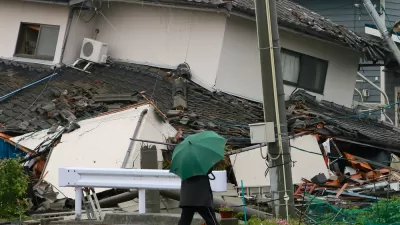Japan is typically associated with strong disaster preparedness plans, but the devastation following the March tsunami highlights some of the nation's shortcomings in adapting and reacting, according to this piece from Citiwire.
Disaster recovery expert Edward J. Blakely writes that there are two main problems holding Japan back from adequately responding to the disaster's impacts.
"A first dilemma: the Japanese were unable to react to a disaster that didn't fit their game plan. We heard and read how they were surprised by the tsunami breaking through the coastal defences, as well as how un-prepared their nuclear team was. But there's a greater issue for Japan lurking behind those surprises. Simply put, it's the Japanese nation's lack of flexibility in response to almost anything and everything that occurs in public and private spheres. On the one hand this characteristic has made the Japanese automobiles and electric appliances and cameras among the most reliable in the world. But when the Japanese operations manual fails, as it did during the tsunami, then the system has few responses, leaving the nation and communities paralysed.
Related to this is Japan's very narrow hierarchy. True, Japan pioneered the notion of assembly line corrections and improvements on the factory floor. But no such approach has been developed in government operations. In fact, virtually all decisions are made at the top - assuming anyone at the top will make the decisions."
FULL STORY: Japan’s Full — and Perplexing — Recovery Needs

Alabama: Trump Terminates Settlements for Black Communities Harmed By Raw Sewage
Trump deemed the landmark civil rights agreement “illegal DEI and environmental justice policy.”

Planetizen Federal Action Tracker
A weekly monitor of how Trump’s orders and actions are impacting planners and planning in America.

The 120 Year Old Tiny Home Villages That Sheltered San Francisco’s Earthquake Refugees
More than a century ago, San Francisco mobilized to house thousands of residents displaced by the 1906 earthquake. Could their strategy offer a model for the present?

In Both Crashes and Crime, Public Transportation is Far Safer than Driving
Contrary to popular assumptions, public transportation has far lower crash and crime rates than automobile travel. For safer communities, improve and encourage transit travel.

Report: Zoning Reforms Should Complement Nashville’s Ambitious Transit Plan
Without reform, restrictive zoning codes will limit the impact of the city’s planned transit expansion and could exclude some of the residents who depend on transit the most.

Judge Orders Release of Frozen IRA, IIJA Funding
The decision is a victory for environmental groups who charged that freezing funds for critical infrastructure and disaster response programs caused “real and irreparable harm” to communities.
Urban Design for Planners 1: Software Tools
This six-course series explores essential urban design concepts using open source software and equips planners with the tools they need to participate fully in the urban design process.
Planning for Universal Design
Learn the tools for implementing Universal Design in planning regulations.
Clanton & Associates, Inc.
Jessamine County Fiscal Court
Institute for Housing and Urban Development Studies (IHS)
City of Grandview
Harvard GSD Executive Education
Toledo-Lucas County Plan Commissions
Salt Lake City
NYU Wagner Graduate School of Public Service




























